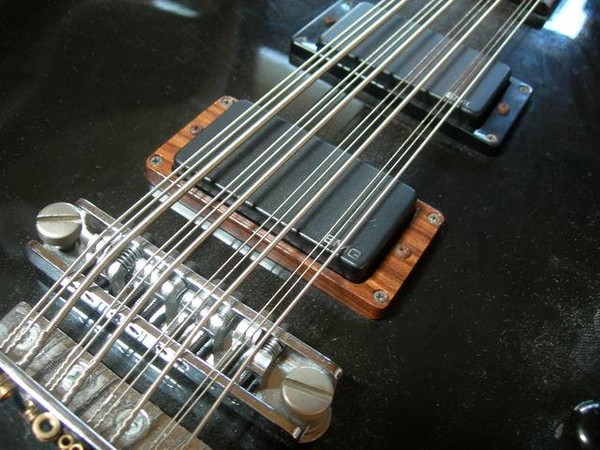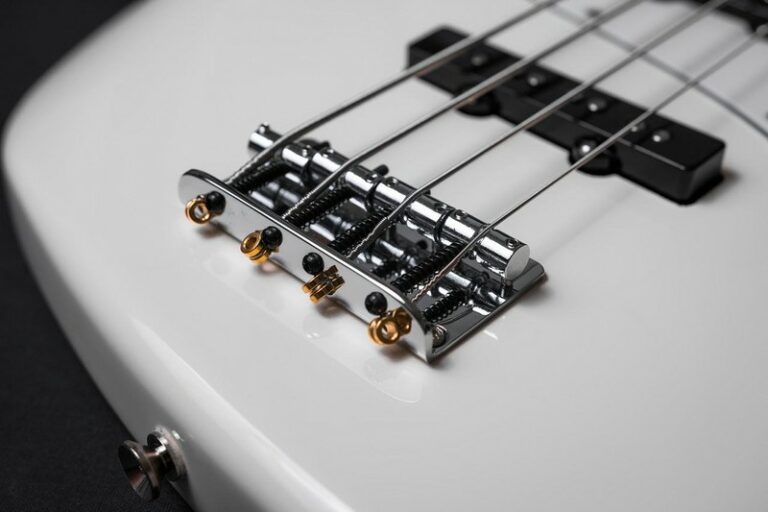Bass guitars and electric guitars have similar construction and look. Bass guitars are bigger since they have a bigger scale length (and neck) and are heavier. The next most apparent difference between the two is the strings, and not only does the bass have a lesser number of strings, but they are considerably thicker.
Bass guitars rely on external amplification and are primarily used in the rhythm section of a band. A band’s rhythm section may comprise a drummer, a bassist and other instruments like rhythm guitar that provide the rhythm, harmony and pulse. Bass guitars usually play the bassline or parts of it and support the harmony.
How Many Strings are on a Standard Bass Guitar?
Bass guitars have the lowest pitch among all of the guitars and typically have four strings. The strings are much thicker than any other guitar and are tuned an octave below standard guitars. With two fewer strings, their pitch range is also less. Like all musical instruments, there are several variations of the bass guitars, mainly with a different number of strings and their arrangement.
Consequently, the four-string bass guitars have come to be known as standard bass guitars.
Tuning of a Standard 4-String Bass Guitar
The strings on a standard bass guitar are in the tuning E–A–D–G (or E1–A1–D2–G2), which is the same as the lower (thicker) four strings of a regular guitar but one octave lower. The pitch range of a standard 24-fret bass guitar is between E1 to G4, and the frequency range is roughly between 41Hz to 392Hz.
| String | Pitch Range |
|---|---|
| First (E) | E1 to E3 |
| Second (A) | A1 to A3 |
| Third (D) | D2 to D4 |
| Fourth (G) | G2 to G4 |
Tuning is the process of assigning a pitch to the individual strings of the guitar. This means assigning notes to open strings (strings played without pressing it on the fretboard).
The fretboard is divided into segments called frets which are thin strips of metal at specific positions. The fret positions are calculated by a complex mathematical formula such that each fret is a semi-tone. And as there are 12 semi-tones in an octave, each string on a standard bass with 24 frets has two octaves.
In addition to the standard tuning, several other tunings are possible in 4 string basses. Some tunings are possible with the standard set of strings, while some require the addition of a thicker string.
Drop-D Tuning
Drop-D tuning is one of the famous bass guitar tunings and is used widely to lower the range even further. The strings in drop-d are tuned to D–A–D–G (or D1–A1–D2–G2), which gives bassists two extra notes–D and D♯ but an octave below that of the standard tuning.
Strings in drop-d tuning have the following pitch range:
| String | Pitch Range |
|---|---|
| First (Low-D) | D1 to D3 |
| Second (A) | A1 to A3 |
| Third (D) | D2 to D4 |
| Fourth (G) | G2 to G4 |
Down Tuning (B–E–A–D)
This is another popular tuning that is used to extend the lower range even further for deep basslines. In this tuning, a thicker B string typically used in 5-string basses is used in place of the E string. The other strings, E–A–D, are shifted down, and the G string is omitted.
This arrangement provides the bassists with five extra low-end notes, B, C, D♭, D and E♭. Though this tuning produces incredible lows that some bassists love, it puts extra strain on the guitar’s neck and body due to the increased string tension.
Extended-range basses such as the 5-string version can also provide these extra low-end notes and might be a better choice in many cases.
Strings in B–E–A–D (or B0–E1–A1–D2) tuning have the following pitch range:
| String | Pitch Range |
|---|---|
| First (B) | B0 to B2 |
| Second (E) | E1 to E3 |
| Third (A) | A1 to A3 |
| Fourth (D) | D2 to D4 |
Up Tuning (A–D–G–C)
Some bassists require more upper range for a specific music piece or for their music styles. Though not very common, they can use the up-tuning A–D–G–C where the E string is removed, and the remaining three strings are shifted up with the addition of a new C string.
This arrangement and tuning add upper-range pitches at the expense of losing the low E string and its notes. Both 5-string and 6-string extended-range basses can provide this additional upper range (the C-string).
Strings in A–D–G–C (or A1–D2–G2–C3) tuning have the following pitch range:
| String | Pitch Range |
|---|---|
| First (A) | A1 to A3 |
| Second (D) | D2 to D4 |
| Third (G) | G2 to G4 |
| Fourth (C) | C3 to C5 |
Extended-Range Bass Guitars
Besides the 4-string version, bass guitars also come in 5- and 6-string versions, which are called extended-range bass guitars as the extra string(s) add additional pitch range.
While the 5-string bass can either provide the extended lower range or upper range, 6-string bass guitars offer both. The downside of using these extended-range basses is that the strings are placed more closely together, which may take some practice for bassists to get used to in the beginning.
5-String Bass Guitars

For someone who wants the deep lows or bright highs, you have the 5-string bass, the most common type of extended-range bass. There are two versions of the 5-string bass, one with an additional low string and another with an extra high string.
The most common type of 5-string has a fifth string tuned to B extending the lower range of the guitar. The standard tuning is B–E–A–D–G (or B0–E1–A1–D2–G2), which provides five additional notes that are not present in regular 4-string basses. The extra notes on the B-string are B, C, D♭, D and E♭. In addition to these notes, the B-string also has many notes from the low E-string. The fretted E-note on the 5th fret of the B-string sounds better and fuller to most people than the E-note on the open E string.
The second and more uncommon type of 5-string bass is one with a high C-string and tuning E–A–D–G–C (or E1–A1–D2–G2–C3). As you can guess, this variation extends the upper range.
5-string basses are popular, especially in rock, metal, and jazz. Metal bands such as Metallica, Megadeth, and Cannibal Corpse have extensively used 5-string bass guitars. Tom Hamilton of Aerosmith also sometimes plays a 5-string bass.
6-String Bass Guitars
A less popular bass guitar version extends both the low and high range by having two additional strings.
One of the additional strings is tuned to B like a 5-string bass guitar discussed above, while the other is tuned to C, which provides the treble or the high range. The standard tuning is B–E–A–D–G–C (or B0–E1–A1–D2–G2–C3).
Though 6-string bass guitars have been around for several decades, the version we see nowadays is something that was influenced by the idea of Anthony Jackson, who conceptualized the 6-string guitar tuned to B–E–A–D–G–C and had one custom-built back in the 1970s.
6-string bass guitars have a wide neck and fretboard, usually requiring greater finger reach and technique to play.
7-String Bass and Beyond
Extended-range bass guitars with 7-12 strings also exist, though very rarely used by musicians. The tunings of these guitars are as follows:
| Guitar Type | Tuning |
|---|---|
| 7-String | F♯ to C or B to F |
| 8-String | F♯ to F |
| 9-String | F♯ to B♭ |
| 10-String | C♯ to B♭ or F♯ to E♭ |
| 11-String | C♯ to E♭ or F♯ to A♭ |
| 12-String | C♯ to A♭ or B to G♭ |
With the increased number of strings, the fretboard’s width also increases, making these guitars challenging to play without enough practice and finger reach.
Differences in Playing Style
The basic techniques used to play extended bass guitars (5- or 6-string versions) are more or less like how you play a standard 4-string bass. Though, guitars with more strings may pose a challenge as the finger reach needed to play notes is more on account of a wider fretboard. The string spacing could also pose some challenges as it is typically much less than a 4-string bass.
The strings in a bass guitar are much thicker and vibrate with more energy than standard guitars. This makes sympathetic vibration much more pronounced. A sympathetic vibration happens when the adjacent strings of the string being played catch the vibration and starts vibrating and making a humming sound.
This unintentional humming sound is a common issue with all bass guitars and muddies the tone unless players mute the other strings. Muting is more or less the only way to achieve crisp-sounding notes in a bass guitar.
This issue is even more problematic in 5- and 6-string bass guitars as there is an extra number of strings.
Other Types of 8-String and 12-String Bass Guitars

The other variation of a non-standard bass guitar is the 8- or 12-string version with double or triple course strings. These guitars do not extend the range of the guitar since strings are in groups of two or three and are therefore not called extended-range bass.
An eight-string bass has two of each strings, while a twelve-string bass has three strings.
These guitars differ from the extended range 8- or 12-string guitars previously mentioned as, to reiterate, the strings on these are in courses. The group’s second or third string is tuned an octave above the main string and is played simultaneously with it, producing a natural chorus effect.
Guitarists also often use a plectrum (pick) to strum the strings, which increases the chorus effect, unlike standard bass guitars that are almost always plucked with fingers.
- Tuning of 8-string bass guitar (in courses) is E2E1–A2A1–D3D2–G3G2
- Tuning of 12-string bass guitar (in courses) is E2E2E1–A2A2A1–D3D3D2–G3G3G2
Famous Guitarists Who Have Used Non-Standard Bass Guitars
A few of the famous guitarists who play or have played these guitars are:
- Jimi Hendrix is one of the most famous musicians who played an 8-string bass.
- John Paul Jones of Led Zeppelin used a 10-string bass guitar in one of their concerts.
Image sources:
- 12-String Bass Guitar by Yagyujube, CC BY-SA 3.0, via Wikimedia Commons


